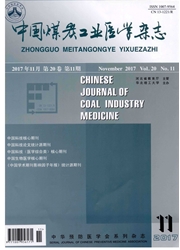

 中文摘要:
中文摘要:
目的探讨对盘状半月板损伤患者经关节镜行不同术式的临床效果。方法回顾性分析2010年3月—2014年5月该院收治的共计74例盘状半月板患者的临床资料。男42例,女32例;平均年龄(39.5±21.1)岁;病程33d~4.5年。患者均经关节镜确诊为盘状半月板损伤。经保守治疗后症状不能改善,遂行关节镜下手术治疗。74例患者中,有50例行盘状半月板成形术(1组),18例行盘状半月板完全切除术(2组),6例行不全切除术(3组)。随访0.5~2年。术后1个月,Ikenchi法评价手术效果。术前、术后1个月、术后1年,分别采用ROM法对膝关节活动范围进行评价。结果术后全部患者的异常症状和体征均得到一定的改善。总体的手术优良率91.2%,但三组间差异无统计学意义(χ~2=2.0,P=0.37)。术后1个月、术后1年,三组患者膝关节活动范围(屈曲、伸直范围)均较其术前有显著的改善(P〈0.05);三组间的差异有统计学意义(P〈0.05)。观察期无严重并发症。仅2例患者术后第三天出现膝关节肿胀,予对症处理(关节穿刺、抽除积血等)后恢复。结论临床经手术治疗盘状半月板时应最大程度的保留半月板功能;除严重撕裂、无法保留者,尽量行半月板成形术。
 英文摘要:
英文摘要:
Objective To study the clinical effect of different operative methods in the patients with discoid meniscus injury by arthroscopy.Methods A retrospective analysis in clinical data of 74 cases of patients with discoid meniscus in author’s hospital during March 2010 and May 2014.Among them,42 of cases were male,32 cases were female.The average age was(39.5±21.1)years.Course of disease was 33 days to 4.5 years.Patients were confirmed by arthroscopy for discoid meniscus injury.Symptoms did not improve after conservative treatment,then they were carried out by surgical treatment under arthroscopy.Of the 74 patients,50 were accepted with discoid meniscus plasty(group 1),18 patients were underwent resection of the discoid meniscus completely(group 2),6 underwent were underwent incomplete resection(group3).Follow-up time was Half a year to 2 years.After 1 month,to evaluate the efficacy of the procedure with Ikenchi method.Preoperative and postoperative 1 month,and 1 year postoperatively,respectively to evaluate the knee joint activities with ROM method.Results All the patients were improved with abnormal postoperative symptoms and signs.General good rate of surgery was 91.2%,but the difference among 3 groups had no statistical significance(χ~2=2.0,P=2.0).After 1 month and 1 year after operation,knee joint range(buckling,extended range)in3 groups of patients had improved significantly comparing with the preoperative(P〈0.05).Differences among the 3 groups was statistically significant(P〈0.05).It was without serious complications during observation period.Only 2 patients had knee swelling in postoperative 3 d,then gained suitable processing(inclding joint puncture and pumping hemorrhage,etc.)and recovery later.Conclusions The clinical treatment of discoid meniscus by surgery should be maximum retention meniscal function.In addition to the severe tear,unable to retain,patients need to underwent meniscus plasty as far as possible.
 同期刊论文项目
同期刊论文项目
 同项目期刊论文
同项目期刊论文
 期刊信息
期刊信息
